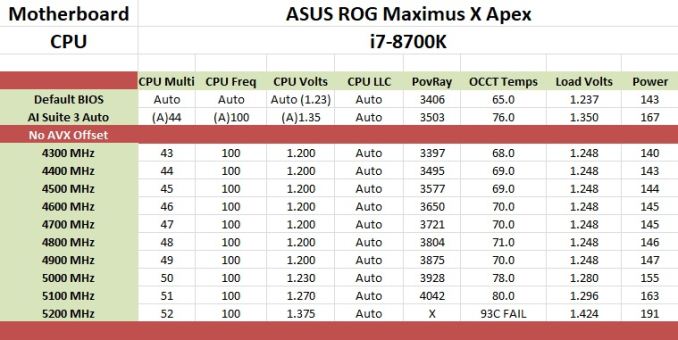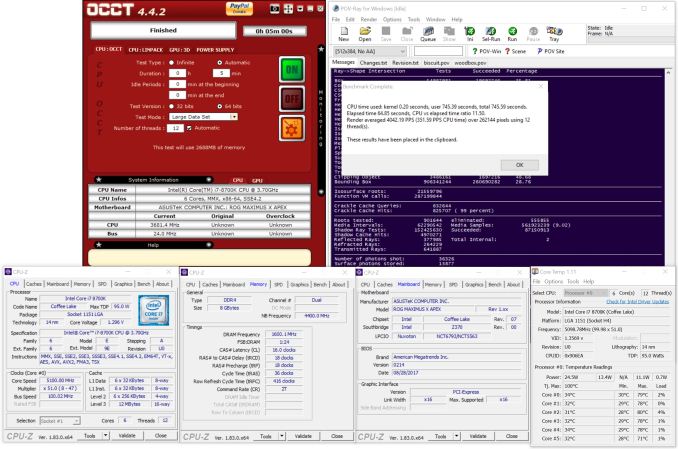The ASUS ROG Maximus X Apex Review: X Marks the Spot, Literally
by Joe Shields on May 11, 2018 9:00 AM EST- Posted in
- Motherboards
- Intel
- Asus
- ROG
- Aquantia
- 5G
- Coffee Lake
- Z370
Overclocking
Experience with the ASUS ROG Maximus X Apex
Overclocking on the Apex should be nothing short of a fun adventure considering all the features it has for it. Granted, a lot of these features, such as the LN2 mode, slow mode, and others are geared towards extreme/sub-ambient overclocking, but the bottom line is that the board is made to be pushed hard among other things. For all intents and purposes, the Z370 platform doesn't have the same issues X299 ran into regarding VRM cooling and using robust enough heatsinks to remove the heat generated by the power delivery system for these power hungry CPUs. We did not run into premature power limits like the SuperO board, nor did this board magically add voltage even when setting it manually like the newborn NZXT we reviewed. The overall experience worked out quite well - I'm just sad I did not have enough time, or a dewar full of LN2 to really see what this chip can do.
For the auto overclocking, I let AI Suite 3 and its 5-Way Optimization set things up. For our part, we selected all core overclocking then hit start. In the end, the process took about eight minutes to complete and generates a report end showing the clocks, peak voltage, wattage, and temperatures. The final product was a 5 GHz peak clock with the cores set to 50/50/50/50/47/47. Curiously, not all cores were set the same as we requested. When running POV-Ray and OCCT I found a -3 AVX offset used which yielded an all core result of 4.4 GHz (versus 4.3 GHz stock). Single threaded applications did run at 5 GHz. As far as voltage stability, with LLC set to auto, I would see the voltage rise above the set value overload - easily mitigated by adjusting LLC to a less aggressive value.
Manual overclocking was met without any challenges from the board, however, the chip did put up a pretty steep voltage wall, marking the end of that adventure. There are enough options in the BIOS to satisfy most anyone, even competitive overclockers. That said, the ASUS BIOS is straightforward with most everything needed under one major section and a couple of sub-headings making navigation quick and easy. The BIOS also includes several overclocking profiles. From a couple of basic "Gamers'" and "5G" profiles to "380 Mhz BCLK" or "B-die 5300MHz", all the profile profiles (12 in total) are found in the Overclocking presets. I tested out the 340 BCLK profile and it worked fine with my setup. I tried the DDR4 4000 profile but these profiles can give a good starting point for pushing the limits on the attached hardware.
Overclocking Methodology
Our standard overclocking methodology is as follows. We select the automatic overclock options and test for stability with POV-Ray and OCCT to simulate high-end workloads. These stability tests aim to catch any immediate causes for memory or CPU errors.
For manual overclocks, based on the information gathered from the previous testing, starts off at a nominal voltage and CPU multiplier, and the multiplier is increased until the stability tests are failed. The CPU voltage is increased gradually until the stability tests are passed, and the process repeated until the motherboard reduces the multiplier automatically (due to safety protocol) or the CPU temperature reaches a stupidly high level (90ºC+). Our test bed is not in a case, which should push overclocks higher with fresher (cooler) air.
Overclocking Results
The ASUS ROG Maximus X was able to take our i7-8700K to new heights reaching 5.1 GHz stable (for our testing) at 1.296V (actual voltage reading from DMM). After that, the CPU ended hitting what seems to be a pretty steep voltage wall at 5.2 GHz. In an attempt to get it stable, I pumped 1.375V yielding 1.424V on load. This yielded stability in OCCT testing but was unable to complete a full pass of POV-Ray. Temperatures in the OCCT testing broke our 90C threshold anyway, so this was our stopping point. I was able to get our memory to 3600 MHz without issue manually, though surprisingly (perhaps due to our kit), I was unable to get either 3733 or 4000 Mhz profiles working with the Corsair sticks. I dropped in a different set of RAM (DDR4-3600) and the profiles didn't have an issue loading up. As always, your mileage may vary when it comes to manual overclocking as well as presets working globally.












39 Comments
View All Comments
PhrogChief - Saturday, May 12, 2018 - link
LOL...Dragonstongue - Saturday, May 12, 2018 - link
IMO they really should have similar spec non LED/RGB bs motherboards for AMD as well as Intel because there are many (such as myself) that have ZERO need or want for RGB anything taking up the BOM for things that are far more useful.such as put the $ towards giving the best most stable VRM or ensuring the m.2 slots have the best cooling possible without having to resort to liquid (would not hurt them to move them away from right underneath the hottest parts in most computers such as graphics cards/cpu)
why can they not maybe figure out a way to place them right behind the sata/motherboard mains power where there tends to be a nice "hole" that is very rarely occupied with anything)
X shaped LMAO, I was expecting a significant X, but it barely cut the motherboard to give a very slight impression of this (and only if you look really closely)
I very much feel the same though, when you call everything X this or X that, Gaming this or Gaming that, Ultra this or Ultra that, the words lose all meaning, because "everyone is doing it"
ROG is a fine branding, and Hero or Formula or Maximus is also fine, they really do not need to add an even longer name on top of this to try to draw extra attention to it IMO ^.^
mapesdhs - Monday, May 14, 2018 - link
Years ago, the ASUS Sriker II Extreme turned heads, as did the Maximus IV Extreme, and definitely the Rampage IV Extreme. These days, the whole notion of such boards has been rather diluted. Fun stuff like PLX chips has largely gone, while the oc headroom of the latest mainstream Intel chip is garbage (why anyone cares about a 6% bump over the official max turbo is beyond me; at least with SB one could easily reach a 28% bump over the official max turbo, and without the need for Iceland airflow to keep it cool). Oc'ing back in the days of S775, X58, P55 and SB was fun, one could relaly push the hw and see some great gains (sooo many delighted 2500K users out there), but now it's just a giant yawn fest. The CPUs are doing a lot of the oc work automatically, and they're getting good at it.mapesdhs - Monday, May 14, 2018 - link
I meant to add, even outside the ROG line ASUS was doing funky things, eg. the P7P55 WS Supercomputer, x8/x8/x8/x8 on a P55 board! :D I hold most of the P55 3DMark records by plonking three 980s on that whacko board. The P9X79-E WS was similarly and usefully OTT, great for compute yet it has most of the same oc potential of the equiavent ROG board (R4E). Modern mbds have gone RGB bling mad because that's all they have left to tout.Dug - Wednesday, May 16, 2018 - link
I agree with the VRM and m.2 slots.I would really like to know why m.2 slots are in such a hot location.
I'd also like to know why Intel won't increase the lanes needed for more bandwidth to devices.
PhrogChief - Saturday, May 12, 2018 - link
COMING SOON: Asus Republic of Maximus GamerX Type R Ultra Rev 2.0 Extreme X599 MASTER EDITION w-Aura Link LightFlow by Strixm16 - Sunday, May 13, 2018 - link
Interesting, I don't know why this high density RAM was not more of a thing back in the DDR3 days, although I could understand the desire to Overclock and those 16GB DIMMs don't allow that in DDR3 (not to mention that most were also ECC applications).I hope the prices go down, because a 16GB DIMM although not a hard thing to find now, it is still very expensive.
Otherwise, this is an amazing board indeed.
Aikouka - Monday, May 14, 2018 - link
Seems a bit odd to go with a 5Gbps port on an expensive motherboard when ASRock is offering a 10Gbps port on their higher-end board (Z370 Professional Gaming i7). Heck, ASUS even releases stand-alone cards with the same chip that ASRock uses, which is the same company that makes the chip for this board.nimi - Tuesday, May 15, 2018 - link
ASUS be like:A: Guys, slapping on RGB just isn't cutting it anymore, we need something new to stand out.
B: *looks up from his fruit X phone* Notches are all the rage these days, what if we added a NOTCH to our board?
A: I think you're on to something! Hey, why not go one step further, let's do FOUR notches!!! I'll bet it'll sell 4 times as fast!
B: Yes! And add "X" to the name for good measure.
A: BRILLIANT